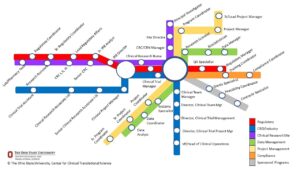Clinical Researcher—October 2023 (Volume 37, Issue 5)
PEER REVIEWED
Jessica Fritter, MACPR, ACRP-CP; Carolynn Jones, DNP, MSPH, RN, CRN-BC, FAAN
Did you fall into the clinical research profession? This is a question we have often asked attendees at national clinical research conferences like those held annually by ACRP. Responses have mostly been a resounding “Yes”! Unfortunately, many people find out about clinical research and clinical research careers by accident or in a very roundabout manner, not even realizing that this field was an option prior to suddenly being part of it and maybe or maybe not seeing a clear path forward to making it a career.
Unfortunately for some, an understanding of the multitude of pathways one can take throughout their clinical research career may be lacking at first.{1} Moreover, students, mentees, and connections from LinkedIn may be aware of the field but find themselves stymied trying to enter it. They often ask us “How can I get my foot in the door?”
Although pathways into the profession may appear unclear due to a lack of consistency across the pertinent roles and institutions, clinical research careers are predicted to grow at a rate of 9% per year and national efforts have paved the way for transformational improvements.{1–3}
We aim to raise awareness by illustrating varied career pathways in clinical research; to “get the word out” for those who are exploring first-level careers (e.g., your first role pursuing a serious career), for anyone looking at second-level careers (e.g., have had a prior career, but desire a new type of career), and for seasoned clinical research professionals who are exploring new opportunities.
Mapping it Out
After attending a clinical research conference, we were inspired by a subway (metro) map. If you have ever traveled by metro, you know that you may only have limited options when you first get on at a nearby station, but you can eventually choose from among many different routes offered at various intersecting hub stations. For instance, you can start out on the red line and then, at a subsequent station that offers them, take the blue line or green line, etc. Based on this idea, our map (see Figure 1) illustrates the myriad clinical research career possibilities out there.
Figure 1: Illustrated Clinical Research Career Map

Keep in mind job titles may vary across the clinical research industry (with employers including pharmaceutical sponsors, device companies, contract research organizations [CROs], technology and service vendors, regulatory authorities, site networks, academic institutions, and more), which makes having an all-inclusive pathway map difficult to accurately display.
Roles in such areas as study coordination, patient recruitment, pharmacy/drug safety, feasibility, medical writing, finance/billing/contracting operations, statistics, data management, safety reporting, informatics, project management, quality improvement, compliance, monitoring, institutional review boards, laboratory services, and sponsored program administration may appear on organizational charts under a dizzying array of titles. Further, careers not illustrated here include those in the supply chain sector, which is a growing and important career area in clinical research, as well as education.
It is also important to recognize that other new career pathways are evolving as the research enterprise meets the new digital age. However, we aim to raise awareness that there are many careers and pathways to success in the clinical research enterprise by illustrating career titles, junctures, and opportunities to change course.
We wanted to illustrate that there are career pathways based on roles or employers, and that there are also opportunities for switching pathways (e.g., from the red line to the blue line) to reach your ultimate destination. While the exact job title may vary between organizations and institutions, this map can provide insights into the variety of roles one can start and grow beyond in your clinical research professional career.
Voices from the Field
The personas below (see Sidebar) are derived from true stories from professionals we know. Such personas can further illustrate clinical research professional career journeys and spark the imagination.
Sidebar: Three Clinical Research Professional Personas
Jane, RN, CCRC, Clinical Research Nurse Coordinator I
Jane is a registered nurse who worked for two years in an emergency department in a community hospital before being recruited to coordinate studies there by a doctor who is also a principal investigator (PI) for several clinical trials on potential new treatments for pain.
“I started working in clinical research one year ago, starting as a Clinical Research Nurse Coordinator I. In my current role, I am responsible for recruiting and consenting participants for six studies. My aim is to progress to Clinical Research Nurse Coordinator II, conducting study visits, collecting data for each study visit, and helping with creating patient educational materials for our studies. Ultimately, I would like to be a clinical research nurse manager, leading a team of study coordinators, negotiating new study contracts, and assisting with new protocol development with my PIs.”
Bradley, BS, CCRA, Clinical Research Associate II
Bradley started his clinical research career at an academic medical center working as a clinical research coordinator for five years in a cancer center. He then switched career paths and started working for a CRO as a clinical research associate.
“I would not be where I am in my career if I had not started out in the academic medical center setting. It allowed me to see a trial be run from start to finish from the site perspective. This has greatly influenced my career at a CRO, where I am responsible for monitoring clinical trials across multiple sites and across various clinical departments. This gives me empathy for the roadblocks sites may face and an understanding of how they may cause delays throughout the study.”
Natalie, BS, MS, ACRP-CP, Director of Clinical Research
Natalie always loved science and medicine but knew she did not want to be an MD or RN. After her undergraduate studies majoring in Biology, she received her master’s degree in clinical research and obtained her certification as an ACRP-CP. She has 10 years of experience and started as a study coordinator, then progressed to a project manager position, and now is a director of clinical research at a private practice research site.
“I absolutely love what I do and each one of my previous positions has allowed me to navigate where I wanted my career to go. Obtaining my master’s in clinical research and my certification expanded my knowledge of clinical research and gave me confidence when applying to be a project manager. Going from a coordinator to a project manager allowed me to take the skills I knew from being on the front lines to what I needed to know when managing multisite studies. In project management, I was introduced to budgets and contracts, which has been a true asset in my role as Director of Clinical Research.”
What Skills Do Clinical Research Professionals Need to Acquire?
Clinical research professionals aim to acquire basic competencies in clinical research based on the Joint Task Force Clinical Trial Competency Framework, which divides skillsets into eight distinct domains: Scientific Concepts and Research Design, Ethical and Participant Safety Considerations, Investigational Products Development and Regulation, Clinical Study Operations (Good Clinical Practice), Study and Site Management, Data Management and Informatics, Leadership and Professionalism, and Communications and Teamwork.{4,5} These competencies are also informed by current federal regulations and International Council for Harmonization (ICH) Good Clinical Practice (GCP) guidelines. Other ICH guidelines also inform distinct competencies across roles.
Depending on the role you work in, your skillsets may focus primarily on entry-level skills in some domains, or higher-level skills in other domains. This framework is the standard basis of onboarding training, continuing education training, clinical research certification, and academic coursework. If you want to gain additional knowledge on these skillsets, you can pursue specialized training at your workplace, from professional organizations like the Association of Clinical Research Professionals (ACRP), and through relevant training opportunities, academic courses, books, and articles from a variety of sources.{6}
Knowing Your Strengths
Take a moment for reflection as you embark on this journey. What is your “why”? What is your passion and how does this combine with your skills? A career path is an individual choice and perspective. It is great to set long-term goals, but first, take the time to look introspectively and reflect.
One helpful tool professionals use assesses your innate personal strengths. The Gallup organization provides resources such as Strengthfinders that can be a tool for identifying your strengths.{7} Some organizations try to align job roles to an employee’s strengths. Not everyone is great at managing, training, or the detailed work of computer data entry. Some may be excellent at patient-facing activities and are clinically oriented. Others are excellent at seeing the big picture and are great project managers. Some individuals may be more introverted or extroverted, thus certain job roles may be more appealing, based on personality traits in addition to innate strengths. There is no one size fits all!
Facilitators to Career Entry
This is a great time to enter the field of clinical research, mainly because of the vast number of job openings in the field across varying employer types. Facilitators to moving into or upwards in clinical research careers include:
Research the field—Explore and understand what sorts of roles are available at your target organization. Gain understanding of the key clinical research features of the organization. Do a little research on the company/institution’s website.
Create a good resume—Avoid trendy resume templates; however, highlighting your skillsets that show your abilities to organize, manage, create, supervise, or coordinate. Any team-related skills are important. Check your spelling and use consistent formatting in your resume, preferably listing your accomplishments in each category in reverse chronological order. Keep a running list of all studies you have worked on as an addendum.
Create a LinkedIn account—Highlight your skills and begin networking with folks in clinical research areas. Note your account on your resume. A lot of learning and networking happen here!
Gain formal and continuing education—One hallmark of a profession is education in the field. There are academic courses and certificates available at the associates, undergraduate, and graduate levels. There are also master’s degrees in clinical research, most of which are 100% online. Depending on what you want to do within your clinical research career, terminal degrees are also available. The Consortium of Academic Programs in Clinical Research features member institutions that offer clinical research degrees, which could be a resource for students seeking additional information on academic degrees.{8} Certification and other licensures require continuing education. Most professionals seek continuing education to stay up-to-date and to progress in their careers. Clinical research is ever changing, and continuing education is essential.
Join a professional association—ACRP offers multiple member benefits, including job listings, continuing education, opportunities for involvement, certification, and networking. Professional organizations like ACRP partner with their members to help advocate for, strengthen, and professionalize the field. Also, explore local chapters of your professional organizations and expand your network in your region.
Become certified—ACRP offers opportunities for multiple certification examinations. Most certifications require two years of experience working in the field of clinical research before being eligible; however, depending on academic education, there could be variations on this requirement. Certification is a major asset for career progression.
Know your strengths—Many career organizations help potential employees explore their personality traits and innate strengths. Do some internal exploration.
Seek an internship—Competitive internship programs are emerging in pharmaceutical companies, CROs, and research sites. Many individuals have found a job through internships.
Explore job openings and job descriptions—Use search engines like Indeed and Zip Recruiter to explore research positions in your area. More and more positions feature remote (at home) options. Also search directly in company or institution websites to explore openings. And when you get that interview, do your homework by researching the company more deeply.
Gain experience—One place that many individuals get their start is at an academic medical center. Working at an academic medical center can position you with access to training and mentoring resources, including exposure to key opinion leaders who are leading the way in researching new discoveries. Often these leaders are funded by the National Institutes of Health or partner with industry to bring new discoveries to human trials. Career paths in the academic medical center setting can be invigorating and rewarding.
Conclusion
Careers abound within the clinical research field. You can assess your skills and strengths, know your why and set a path. Recognize the value of experience, so don’t be too quick to jump around once you enter the field. Most importantly, network, network, and network through professional social media (e.g., LinkedIn, ResearchGate), professional associations, and conferences. The job market is strong, and the enterprise is making headway in advocating for clinical research professionals across the spectrum of roles and employers.
Our goal is that one day, students in high school and college will intentionally target clinical research as a professional pathway. We hope that when we ask you at conferences if you “fell” into clinical research, less hands will go up! We hope this article and map will help others see all the opportunities within clinical research and know they can make themselves a rewarding and fulfilling home within this profession.
References
- Freel SA, Snyder DC, Bastarache K, et al. 2023. Now is the time to fix the clinical research workforce crisis. Clinical Trials. doi:10.1177/17407745231177885
- Knapke J, Snyder D, Carter K, Fitz-Gerald M, Fritter J, Kolb H, . . . Jones C. 2022. Issues for recruitment and retention of clinical research professionals at academic medical centers: Part 1 – collaborative conversations Un-Meeting findings. Journal of Clinical and Translational Science6(1):E80. doi:10.1017/cts.2022.411
- Knapke J, Jenkerson M, Tsao P, Freel S, Fritter J, Helm S, . . . Jones C. 2022. Academic medical center clinical research professional workforce: Part 2 – Issues in staff onboarding and professional development. Journal of Clinical and Translational Science6(1):E81. doi:10.1017/cts.2022.412
- Sonstein SA, Namenek Brouwer RJ, Gluck W, Kolb HR, Aldinger C, Bierer BE, Jones CT. 2020. Leveling the Joint Task Force Core Competencies for Clinical Research Professionals. Ther Innov Regul Sci 54(1):1–20. doi: 10.1007/s43441-019-00024-2
- Joint Task Force for Clinical Trial Competency. https://mrctcenter.org/clinical-trial-competency/
- Association of Clinical Research Professionals. https://acrpnet.org
- Rath T. 2007. Strengthfinders 2.0. Gallup Press: Washington D.C.
- Consortium of Academic Programs in Clinical Research. https://coapcr.org/
This publication was supported in part by The Ohio State University Center for Clinical and Translational Science (CCTS) under Clinical and Translational Science Award (CTSA) grant number (UM1TR004548) from the National Institutes of Health (NIH).

Jessica Fritter, MACPR, ACRP-CP, is Associated Faculty of Clinical Practice at The Ohio State University College of Nursing, works as a partner in BJE Consultants, and serves as the ACRP Content Committee Vice Chair for 2023 as well as Chapter President for the Ohio Chapter of ACRP. She also works in workforce development for The Ohio State University Center for Clinical Translational Science.

Carolynn Jones, DNP, MSPH, RN, CRN-BC, FAAN, is a Professor of Clinical Nursing and Director of the Master of Clinical Research program at The Ohio State University. She is also co-director of workforce development for The Ohio State University Center for Clinical Translational Science.



